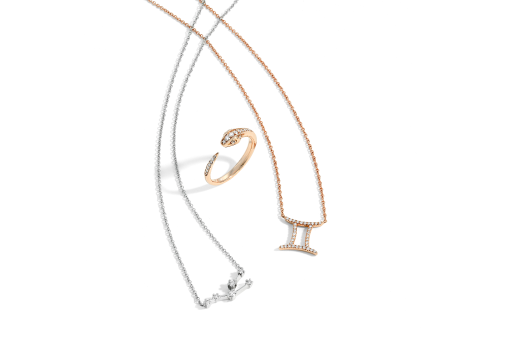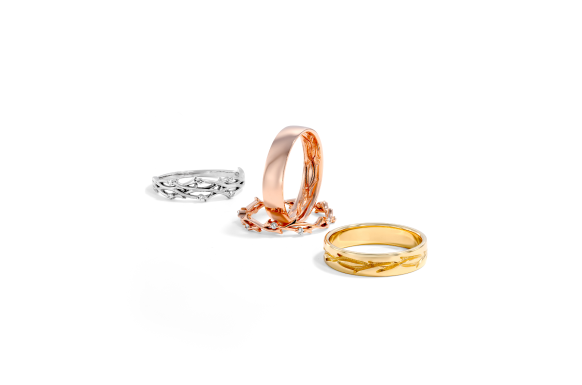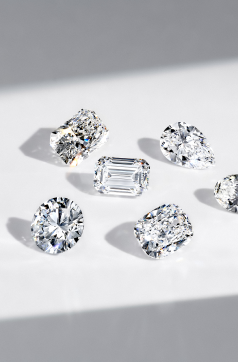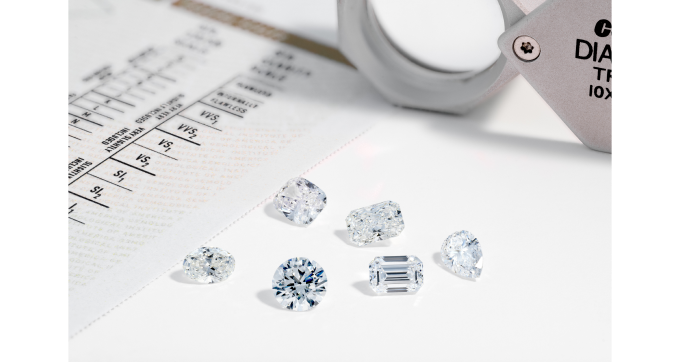Shapes - Oval
Education Center
Education CenterEverything You Need to Know About Oval Cut Diamonds
Oval cut diamonds are admired for their smooth elongated shape, which makes them appear larger than other cuts of the same carat size. They share the same 58-facet structure as round brilliants, delivering maximum sparkle while offering a distinct, graceful outline. Evaluating an oval means paying attention to the 4Cs, as proportions, color, and clarity all affect how the stone performs. Compared with rounds, cushions, and emeralds, ovals stand out for their combination of size, presence and powerful sparkle. Whether natural or lab-grown, an oval diamond remains a versatile choice that balances beauty with value.Quick Summary
Oval cut diamonds have become one of the most popular shapes because they balance brilliance with a graceful silhouette. Brides revealed that oval cuts account for 22% of all diamond engagement rings, a marked increase from just 2% a few years previously. Vogue also noted that “oval engagement rings” was the top-searched ring cut on Google over the past five years.
When you shop for an oval diamond, it’s important to understand what distinguishes this cut and how to select the right stone. Every element, from cut quality to carat weight, shapes how the diamond appears and performs. This guide explores everything you should know about oval cut diamonds, from their radiant history to the qualities worth seeking, and why they remain one of the most sought-after styles today.
History of the Oval Cut
The oval cut dates back to the 1960s, when diamond cutter Lazare Kaplan introduced the modern version of the shape. His approach built on earlier elongated stones but refined the proportions to enhance sparkle and symmetry. The result was a cut that combined the fire of a round diamond with the unique silhouette of an oval.
Over the decades, this cut has become a favorite choice for people who want a classic and beautiful diamond with a slightly different style and presence. Its popularity has grown as celebrities like Hailey Bieber and Blake Lively choose oval engagement rings, bringing the shape into the spotlight.
Today, oval diamonds are among the most requested cuts, celebrated for their versatility and flattering proportions. They’re especially popular for engagement rings and other fine jewelry, with many modern settings like The Penelope and The Twig designed to highlight their beauty. From red-carpet appearances to everyday wear, the oval cut thrives as a modern classic, offering sparkle, sophistication, and a shape that feels current yet enduring.
Buying Tips for Oval Diamonds
When you look at oval cut diamonds, the 4Cs - cut, color, clarity, and carat weight - shape both their beauty and value. Paying close attention to how they work together helps you select an oval that shows both brilliance and balance.
Cut Quality
Cut quality is the foundation of an oval diamond’s appeal. A classic oval ratio usually falls between 1.35 and 1.50, making it balanced without leaning too much toward round or narrow. Stones on the lower end of that range appear fuller, while those on the higher end are more elongated. Both options are breathtaking when their quality is good, but they create very different impressions, so cut is one of the most personal choices a buyer can make.
Color
Color is especially visible in ovals because the shape exposes more surface area. Tint tends to show at the ends and edges, particularly in longer ovals with wide facets. To maintain a crisp, bright appearance, higher color grades are recommended: H and above keep the diamond looking white and balanced from tip to tip. For those who want a cool, icy look, choosing F or E grades ensures the stone remains consistently bright across the face.
Clarity
The oval’s faceting scatters light and hides most imperfections, but you still want to look for a good clarity grade. Choosing a diamond with VS2 clarity or higher is often the safest way to ensure that any inclusions remain invisible to the naked eye. This way, the oval delivers its full brilliance without anything distracting from its overall beauty.
Carat Weight
Carat weight determines not only how much the diamond weighs, but also how it appears on the hand. Ovals distribute their size across the top, creating a generous face-up area that makes them look larger than other shapes of the same weight. Shorter, wider ovals give a bold impression, while longer, slimmer stones create a refined, elegant look.
Popular Settings for Oval Cut Diamonds
Oval cut diamonds pair beautifully with a wide range of engagement ring settings. This adaptability is part of why ovals have become such a sought-after choice: they not only flatter the finger but also blend seamlessly with both classic and modern design styles.
Vintage
Vintage settings like The Amber look exquisite with an oval cut diamond. The classic shape enhances the vintage-inspired milgrain and engraving, drawing the eye to its romantic details. Paired with the fine detailing and polished band, the oval diamond adds graceful brilliance, creating a balanced engagement ring that feels timeless, elegant, and beautifully refined.
Side Stone
Side-stone settings like The Lindsey bring balance and dimension to an oval diamond. When paired with marquise or round-cut diamonds, the design draws the eye toward the center. This arrangement emphasizes the oval’s smooth outline while adding depth and symmetry.
Pave
Pave settings like The Pave Nelly add a luxurious touch by lining the band with rows of tiny diamonds, creating continuous shimmer around the oval center stone. This luxurious style draws extra attention to the diamond, and provides extra brilliance without overwhelming the design.
Halo
Halo settings like The Kylie are a favorite for oval cuts, offering extra radiance and enhancing the diamond’s perceived size. The diamond halo frames the stone in a circle of smaller diamonds, amplifying sparkle and creating a show-stopping effect.
How Does the Oval Cut Compare with Other Shapes?
While oval cut diamonds share certain qualities with other popular shapes, they also have distinct differences. Looking at how ovals measure up against rounds, cushions, and emeralds highlights the advantages of this cut.
Oval vs. Round Brilliant
Round brilliants are known for their perfect symmetry and are the most widely chosen diamond shape. Ovals, while sharing the same faceting, create a different impression with their longer form. Instead of perfect symmetry, they embody flow and movement, making them an appealing choice for buyers who want brilliance presented in a less conventional outline.
Oval vs. Cushion Cut
Cushion cuts feature a square or rectangular outline with rounded corners, giving them a softer appearance. Because cushions carry much of their size in depth, they can appear smaller from above when compared with an oval of the same weight. They also have a faceting pattern that creates a “crushed-ice” effect, whereas the oval cut is all about amplified sparkle and fire.
Oval vs. Emerald Cut
Emerald cuts are admired for their step-cut facets, which emphasize clarity and create broad, mirror-like flashes of light. While striking, they don’t offer the same degree of luminosity as an oval cut. Buyers drawn to sparkle usually prefer the oval, while those who want a sleek, glassy appearance may favor the emerald.
|
Feature |
Oval Cut |
Round Brilliant |
Cushion Cut |
Emerald Cut |
|
Facet Style |
Brilliant (58 facets) |
Brilliant (58 facets) |
Brilliant or modified brilliant |
Step cut |
|
Shape |
Elongated, flowing outline |
Perfect circle, balanced symmetry |
Square / rectangular, rounded corners |
Rectangular, clean lines |
|
Light Return |
Bright, scattered sparkle |
Highest overall brilliance |
Softer sparkle, deep flashes |
Broad flashes, less sparkle |
|
Profile Impact |
Creates length and openness |
Compact, classic look |
Compact, soft profile |
Sleek, glass-like appearance |
|
Style Appeal |
Lively and elegant |
Traditional and timeless |
Romantic and soft |
Refined and structured |
Pros and Cons of Oval Cut Diamonds
Like any diamond shape, oval cut diamonds carry distinct strengths along with details that deserve careful consideration. By understanding both their advantages and potential drawbacks, you can make a confident choice and fully appreciate what this timeless cut has to offer.
Pros of Oval Cut Diamonds
-
Larger Appearance per Carat: The longer surface area of an oval diamond creates the impression of a larger stone. This makes it an attractive option for those who want a diamond that looks more substantial without necessarily increasing carat size. The illusion of greater spread gives buyers more visible sparkle for their investment.
-
Flattering Shape: The stretched outline of the oval has a slimming effect on the finger, which many find especially elegant. This quality has made the oval cut a go-to choice for engagement rings meant to feel refined and timeless.
-
Brilliant Sparkle: Because the oval cut is derived from the round brilliant, it carries many of the same light-reflecting qualities. The 58 facets are designed to capture and return light, making it appealing to buyers who want sparkle comparable to a round diamond but with a more distinctive shape.
Cons of Oval Cut Diamonds (and How to Avoid Them)
-
Bow-Tie Effect: A shadow across the center, known as the bow-tie, can appear in poorly cut stones. The solution is to choose a stone with excellent cut quality and an ideal length-to-width radio (around 1.35-1.50). A well-cut and proportioned oval will have only a minimal bow-tie that doesn’t distract from its appearance.
-
Visible Color and Inclusions: Imperfections and tint can be more noticeable near the ends of the oval. To avoid this, choose a stone with slightly higher color and clarity grades, or look for settings (like halos or petal prongs) that help mask these areas while keeping the diamond’s sparkle front and center.
-
High Demand for Quality Stones: Because well-cut ovals are so popular, they can be harder to source. Working with a trusted jeweler gives you access to carefully curated options and expert guidance. You’ll also receive certification from trusted authorities like the GIA or IGI, confirming the quality of your stone.
Explore Keyzar’s Oval Cut Diamonds
An oval cut diamond features brilliance, beauty, and a flattering shape that turns any piece of fine jewelry into a work of art. At Keyzar, we curate a wide selection of oval cuts in both natural and lab-grown options, giving you choices that fit a range of styles and budgets. Explore our wide collection of oval engagement rings today and make one yours!



